G. L. Pease
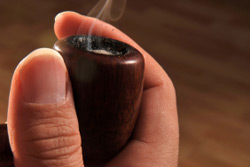 At this writing, there are no questions from anyone named Kevin, though the conspiracy could still be alive and well, and I’m just being lulled into complacency. If you don’t know what I’m talking about, you haven’t been paying attention. There are some great questions in this edition, so without further ado, let’s dive in. The water’s great.
At this writing, there are no questions from anyone named Kevin, though the conspiracy could still be alive and well, and I’m just being lulled into complacency. If you don’t know what I’m talking about, you haven’t been paying attention. There are some great questions in this edition, so without further ado, let’s dive in. The water’s great.
Luigi queries: Hi there Greg, I would like to ask which factor determines the different grades of Virginia flue-cured leaves (lemon, bright, orange, red, etc). Is it the result of a longer exposure to heat, or does it depends on more aging time, or is some other process involved?
A: Luigi, your question is simple on the surface, but the answer runs quite deep. I’ll do my best to summarize.
The color grade of various bright leaf, when harvested, is dependent upon a number of factors, including stalk location, growing region and conditions, maturity at harvest, the seed stock used, and so on. Leaf can range in hue from bright yellowish, to orange, to red to green. The higher the stalk position, the better the leaf, generally, and nearly all of what we will find in our pipe tobaccos is from the mid-position of the stalk and above. Different growing regions tend to produce leaf of distinct characteristics, much in the same way that terroir is reflected in different wine grapes form the same varietal.
Younger, tender leaves at the top of the stalk are generally the sweetest, most aromatic and mildest, while the mid-stalk leaves generally have a lighter taste, but a bit more sharpness, and they can add character and depth to the smoke. Interestingly, though it’s commonly believed that red virginias have higher sugar content than yellows, the reverse is often the case; sugar content, which can range from 10% or lower to over 20%, cannot be reliably predicted from leaf color alone, and neither can nicotine content, though generally speaking, darker leaf tends to be stronger.
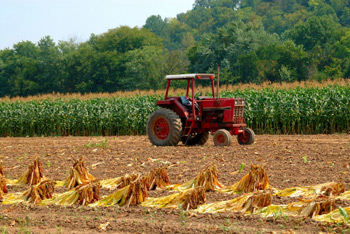 When the leaf is picked, it’s still alive, and its biochemical processes continue; as long as moisture and nutrients are available, the leaf’s cells will continue their metabolic activity. This is where curing comes into play. By drying the tobacco quickly in flue-heated barns, a process that takes only a few days (unlike the 5-6 weeks for burleys), the leaf is effectively killed, setting the sugar and the color. But, the process does not end there. Freshly cured tobacco tends to be harsh and acrid, and has not yet developed its full flavor. Before it can be used, it must be aged in bulk for up to three years under controlled conditions, during which time it will mellow and further develop. During this process, some darkening can take place, so the final shade can be quite different from that of the original cured tobacco.
When the leaf is picked, it’s still alive, and its biochemical processes continue; as long as moisture and nutrients are available, the leaf’s cells will continue their metabolic activity. This is where curing comes into play. By drying the tobacco quickly in flue-heated barns, a process that takes only a few days (unlike the 5-6 weeks for burleys), the leaf is effectively killed, setting the sugar and the color. But, the process does not end there. Freshly cured tobacco tends to be harsh and acrid, and has not yet developed its full flavor. Before it can be used, it must be aged in bulk for up to three years under controlled conditions, during which time it will mellow and further develop. During this process, some darkening can take place, so the final shade can be quite different from that of the original cured tobacco.
Once aged, the tobacco is ready to be processed for use. It can be conditioned (brought up to the proper moisture level for handling) and cut, ready to be blended, or it can be pressed and further aged in cakes, where it will continue to ferment, resulting in a much darker product. In fact, one well known “red virginia” begins life as a bright golden leaf; it’s the caking and aging that gives it its red hue.
Something similar is true of teas. Green teas, oolongs and black teas differ primarily in the way the leaf is processed after harvesting. Darkening is a product of enzymatic oxidation. In the case of green teas, and especially the so-called “white” teas, the leaf is heated to inactivate the enzymes that cause the fermentation to take place—basically the equivalent of flue-curing. Darker teas are allowed to oxidize longer until the desired characteristics are achieved.
So, when a manufacturer talks about the various shades of leaf being used, it may or may not be reflected in the appearance of the finished product, and when the end user discusses the color of a virginia, it may or may not have anything to do with its original hue. Confusing, innit?
Tony wants to know: On many occasions when you refer to the love of a pipe, you mention the briar becoming a seemingly integral part of the smoking experience, not in handling alone but in taste. Maybe I haven’t smoked a fine enough pipe yet to taste the effect that briars lend to the smoke? Hell I dunno. I am really puzzled as to what I need to pay attention to in order to ‘get’ the taste of the pipe along with my tobaccos, for instance Solani ABF or Wessex Burley Slice, or your JackKnife or your Cumberland, etc. Will you give us some feedback on this?
A: Sure. Now, put the microphone very close to the speaker, and turn up the volume. There. Feedback. Oh, sorry. This isn’t my music column…In my experience, every pipe has its own personality, it’s own spectrum of flavors. Some will enhance the brighter tastes, some will mute them. Some pipes deliver a deep, rich smoke, whilst others offer a starker rendition from the same tobacco. It’s not really a question of good or bad, though that does sometime enter the picture, but just a matter of difference. There are pipes that seem to favor one style of tobacco, for instance virginias or mixtures, over another, and others that seem to be content with whatever is stuffed into them. Many things can influence this, including the curing of the briar, the geometry of the bowl, the drilling of the airway, how much the pipe has been seasoned by smoking, and so on.
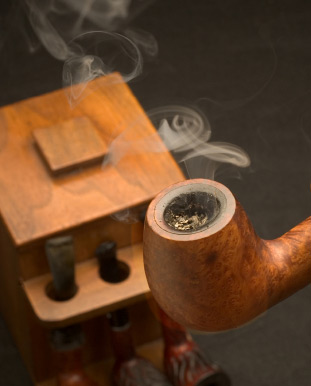 One possible factor in my own smoking is that I tend to keep the cake in my pipes much thinner than most. A thicker cake does seem to even out the differences between pipes to some extent, but I’ve always preferred the thin cake, so it’s probable that my experiences will be somewhat different from someone who prefers a thick cake, which tends to isolate the briar from the leaf. (Readers, please weigh in on this.)
One possible factor in my own smoking is that I tend to keep the cake in my pipes much thinner than most. A thicker cake does seem to even out the differences between pipes to some extent, but I’ve always preferred the thin cake, so it’s probable that my experiences will be somewhat different from someone who prefers a thick cake, which tends to isolate the briar from the leaf. (Readers, please weigh in on this.)
What I do know is that when a pipe and tobacco come together that are “made for each other,” something wonderfully magical happens. Those are the most memorable smokes. I can still easily recall a bowl of five-year-old Drucquer Red Lion in a Barling Quaint brandy that a friend let me smoke after one of the short-lived San Francisco pipe shows. That tobacco in that pipe sang beautiful music for me. I still, over twenty years later, wish I’d have talked him out of it.
Tim poses the following puzzle: Over the last year I have acquired 3 new artisan-made pipes. All three have had hairline fractures occur in bowl around the airhole, usually in a fine spider web pattern. I do not smoke wet tobacco or smoke hot at all, and I am careful in breaking in a pipe. The cracks do not impact the smoking experience, and with use are covered up with cake. I have never had this issue before, the only thing that has changed is that I moved to a new house, and my pipes are kept in a cabinet that is maybe 10 feet from a wood fireplace – not sure if the fire is drying out the air at that distance from the pipes, and therefore taking moisture from the pipes (?) – and I do not regularly have a fire going anyway. It could be me, it could be the briar, it could be a non-issue. Why is this happening, and in the long run is it detrimental to the pipes? One of the pipes had a bowl coating, 2 did not. To be fair, until recently I wasn’t exactly checking out the inside of my bowls unless I was cleaning, so maybe this always happened and I just never looked.
A: Unfortunately, there’s really no way to answer this definitively. It’s possible, as you note in the last sentence, that you just never noticed it before. It’s not likely that these pipes are doing anything different than any other pipe would under the same conditions, assuming they were carefully crafted from good, well-cured briar. Spider-webbing is generally a sign of too much heat in contact with the wood, and the draught hole is a prime location for this to happen, since there are sharp edges where the hole meets the chamber.I doubt there’s anything to worry about, really. If the cake is developing evenly and you’re not seeing dark spots on the outside of the pipes, or getting the foul taste of burning briar in your smokes, things are probably okay. But, it might be a signal to slow down a little, keep the embers cool, even though you say you’re not a hot smoker. Then again, slowing down a little is something that would likely benefit most of us, and not just in our pipe smoking.
From Shawn: I am a home blender. Mainly I produce plugs. I have mutilated several pounds of innocent tobacco before I figured out a basic formula to making good plug tobacco from whole leaf. So you being one of the worlds best blenders are indeed one of my heroes. I am doing well considering I use caveman tools. I have made some good VaPer plugs and a lot of Virginia plugs that are cased with various sugar solutions but have hit a wall. I really want to produce something with a citrus note like MacBaren’s navy flake or Orlik GS. Would you be willing to tell me what they may use to get this subtle flavor? Thanks for listening. and have a great day.
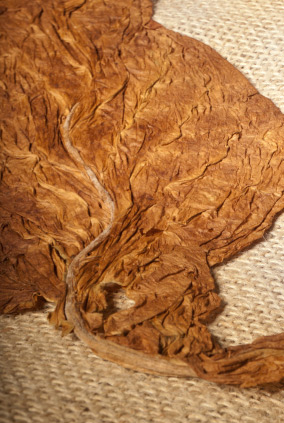 A: Thanks for the kind words, Shawn. Tobacco mutilation is always fun! If you’re doing a lot of sugar casing, you might be working counter to what you’re looking for, as the sugars will tend to smooth out the smoke and reduce the sharp edge that might be the”citrus” note you’re chasing. Of course, the tobaccos you mention are certainly cased fairly heavily, so it’s possible you’re not casing them enough! Try doing something with brights, perhaps just a whisper of perique, no added sugars, and press it only long enough to get it to hold together, and see what that does for you.
A: Thanks for the kind words, Shawn. Tobacco mutilation is always fun! If you’re doing a lot of sugar casing, you might be working counter to what you’re looking for, as the sugars will tend to smooth out the smoke and reduce the sharp edge that might be the”citrus” note you’re chasing. Of course, the tobaccos you mention are certainly cased fairly heavily, so it’s possible you’re not casing them enough! Try doing something with brights, perhaps just a whisper of perique, no added sugars, and press it only long enough to get it to hold together, and see what that does for you.
John asks: I know that most varieties of tobacco improve with age. But do aromatic blends improve? Is there a point when they start to lose taste? Any wisdom you can share would be appreciated.
A: It really depends on the tobaccos used in the base blend, and how much chemistry is employed in the flavoring. Many aromatics are burley based. Assuming they’re not over-saturated with PG, which tends to arrest further development, they’ll mellow out over time, and if stored in a properly sealed container, will retain much or most of their aromatic qualities. If they’re virginia based, they’ll almost certainly continue to ferment and age in their vessels. Of course, if they’re heavily cased and sauced, the more subtle changes due to age might well be masqued by the flavorings. It’s difficult to predict with certainty what will happen to any tobacco over time. The best thing to do is to put a few small sample jars up, perhaps about an ounce in each, and revisit the blend over time to evaluate what’s going on with it. At six months, and then at one year, you should start to really notice a difference if there’s going to be one. Chances are fairly good that nothing bad will happen, and it just might turn into something wonderful.
David ponders: Why no pipe calendar for 2013? They were outstanding and occupied a sacred space on my wall – which is now bare!
A: The decision not to do the calendar this year was a very difficult one for me. A great deal of thought, time, and sweat goes into the production of each edition, and a decline of sales coupled with rising costs each year brought things to the point where it just wasn’t feasible to do it again. As yours is only the third email I’ve received asking about it, it seems it was probably a good decision. Though the selling price of the calendar is significant, I received only a fraction of that price. In order for it to be worthwhile, at least 100 copies would have to sell, and last year, the total sales were just over half that number. As much as I hated to pull the plug on it, it was the only thing that made sense for me.
Ip do still plan on bringing all the images from years past, as well as many more together into book form. I’m hoping to spend some time on it during the next few months, and hope to have it ready before year end. Wish me luck!
Keep those cards and letters coming!
-glp
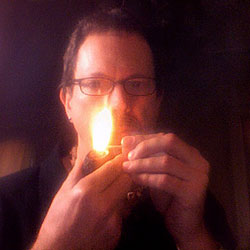 Since 1999, Gregory L. Pease has been the principal alchemist behind the blends of G.L. Pease Artisanal Tobaccos. He’s been a passionate pipeman since his university days, having cut his pipe teeth at the now extinct Drucquer & Sons Tobacconist in Berkeley, California. Greg is also author of The Briar & Leaf Chronicles, a photographer, recovering computer scientist, sometimes chef, and creator of The Epicure’s Asylum. See our interview with G. L. Pease here. |

















Loved the question about the types of virginia leafs. Great answer as well. Thanks for all your hard work Greg. Keep up the great work. 🙂
Thanks for the kind words. I’ll keep at it as long as there’s someone on the other end to read it.
“One possible factor in my own smoking is that I tend to keep the cake in my pipes much thinner than most. A thicker cake does seem to even out the differences between pipes to some extent, but I’ve always preferred the thin cake, so it’s probable that my experiences will be somewhat different from someone who prefers a thick cake, which tends to isolate the briar from the leaf. (Readers, please weigh in on this.)”
Weighing in – and saving a double post with “Out of the Ashes”; an appreciation of the taste of a good briar pipe is the thing that differentiates briar smokers from meer lovers and puts one firmly on the side of the briar v brand debate.
IMO thick cake militates against this experience (as well as muddying tastes by retaining ghosts); even worse are impervious bowl coatings such as water glass (sodium silicate) which, for me, removes all the initial pleasurable taste of a good briar.
I was happy to see the question regarding the relationship between briar and tobacco. I recently opened a tin of your Ashbury blend, which is excellent especially being a Bay Area piper and having a poet wife (I love your tin descriptions). I smoked it in three different pipes all dedicate to Latakia mixtures and I have to say two of the pipes smoked exceptionally well while the other seemed to put a focus on the Latakia component and muted the VA’s and Orientals that to me make this an outstanding smoke. The interesting thing is that I have thoroughly enjoyed other Balkans in the same pipe, but for me I missed what was happening with the brighter notes from the VA’s in this pipe. The more blends I put through my pipes the more I understand what they want, in turn allowing me to have better experiences while smoking. Thanks for another great edition Mr. Pease and I look forward to cracking open the next for of your blends I have cellared now!
LMAO!!! Love it Greg, the opening line in your response to my question. I like how you think! I had some quiet down time here at work and when I read your response I BURST out laughing. some folks looked and me as if i were a little nutty? So What!Thank you ind sir, you’ve given me some good food for though about maybe trimming some cake from some bowls.
Neat article!
Thanks!
Thanks for such a well written and informative discussion. Tobacco leaf grading and selection has always mystified me. I’m not sure you cleared the fog I’m in, but you go a long way toward helping me understand the complexities.
.
As for the interaction between pipe and tobacco, I’m a “thin cake guy” also. I can relate an experience that, while not addressing the fortuitous pairing of pipe and blend, does suggest that there is far more interaction than normally supposed. For years, I had smoked a lacquered Butz-Choquin bulldog whose finish had simply never colored; but it produced acceptable, albeit mediocre, smokes. Spurred to action by forum discussions, I summoned the courage to sand off the lacquer finish (and some wood stain in the process), and I replaced it with carnauba wax. The pipe immediately came to life producing absolutely wonderful smokes and a deepening cherry brown hue. It seems that B-C had traded performance for cosmetic appeal: the lacquer had been masking some unsightly fills. I have since gone on to remove the lacquer finishes from a Rattray’s and a Nording pipe with similar results. I am amazed by the correlation of performance and color change — which, if nothing else, suggests that the pipe is not a passive instrument.